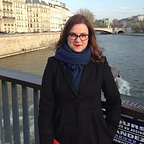Notes from my first 3 months at Citizens Advice
When I joined Citizens Advice 3 months ago, I had a lot of good intentions around writing weekly notes to share what I was learning and thinking about. But then of course life happened, and weekly notes never materialised — and in fact, I’m not sure whether that’s such a bad thing: while I can see the value of writing regularly about our work, quite a lot of my thoughts needed some time to settle in and develop before they could be meaningfully shared.
I’ve learned an awful lot over the last 3 months. I got to know my teams (service design, user research, product design and seamless customer journey) and my colleagues across the organization. I familiarized myself with a very different funding model from the one I knew at Cancer Research UK, and with the incredible work everyone had been doing in response to the pandemic. I sang along to Oasis during a virtual Away Day, shared my user manual with anyone who’d care to see it, and revealed my (not so) secret fondness for EastEnders.
At times it’s certainly been tricky to join a team remotely (although a challenge made much easier by the fantastic induction deck and Trello boards developed by Kylie and Jo), but it’s also been an absolute joy and privilege to become a part of it. And while it was all happening, here are the top 3 things I thought about, all summarised in one bumper edition of quarterly notes…
- Design and user research people in ‘traditional’ organisations need to see themselves as change agents
The Service Design team at Cancer Research UK evolved from a team of transformation roles that we used to call ‘proposition managers’. This meant that when we worked with We Are Snook to embed service design into the charity, we made sure to keep an explicit change skillset into the roles. Our design and user research teams at Citizens Advice are also expected to be change agents and deliver transformation through their work, but we don’t make that as explicit in their skills framework and role descriptions.
This matters, because being a designer or a user researcher in a large, ‘traditional’ (by which I mean non-digital native) organisation requires a different set of competencies and behaviours from being in a similar role within a digital startup or a large tech company — and I think this needs to be called out, recognized and supported, so that people are able to do their best work, and the organization can hear their voice in the right way.
One of the things I’m most excited about for the next few months is partnering with Emily Webber at Tacit to develop a new capability model and skills framework across our Customer Journey, Technology, Data and Impact teams, so this will be very much something for me to consider more deeply.
2. Engaging with architecture and systems is hard, but non-negotiable
Time and again I’ve gone back to Sarah Drummond’s iceberg of ‘full stack service design’. Often teams’ research has to stop at the levels above the water, or the work looking at the top layers is somewhat disjointed from the work looking at the layer that sits under the water — perhaps happening in different teams. But what sits under the water level is extremely likely to make your best above-the-water efforts sink.
If you work in an organisation that has existed for longer than 10 years, there is likely to be a gaffa-tape monster of tech estate lurking in the corner (thank you Emma for the chat that led to this slightly spooky image!), and a team who’s required to know how to handle that monster (and spends a lot of their time doing this, whether they like it or not). However tempting it may be to avoid the existence of the monster or to assume you can go around the iceberg (whichever metaphor works for you!)… you almost certainly won’t be able to, if you intend to deliver real, lasting change.
Ensuring that research and design teams are able to engage with products and technology systems and architecture is crucial to me — and it means building in relationships, cross-team ways of working, but also knowledge and expertise which may occasionally push the teams beyond their comfort zone, as well as a governance that helps us find dependencies between the decisions we make.
3. It’s not (just) the remoteness, it’s the pandemic
Plenty has been written in the last few months about working from home, and I’ve benefited from the lessons learnt by many others on how to best start a job and work remotely. But there is another, obvious layer of fatigue and heart-brokenness we’ve all been dealing with, and our energy resources are struggling to keep up. Citizens Advice provides truly amazing support with well-being, but something I’ve been trying to consider is how we adapt the pace now, throughout the rest of what will still be a long winter, and then into next spring and summer when, even if things should be better, we will all need quite a lot of recovery time. There is a long path ahead of us.
Being remote means I can’t see how my teams look when they come out of a meeting, gauge the levels of energy during workshops, or go for an impromptu coffee when someone needs a chat, and this makes it a lot more difficult for me to be confident that I’m offering the right level of support. I’ve been experimenting with informal structures to stay in touch with people, but I don’t feel I’ve found the perfect answer yet, so this will be a major area of focus for me well into 2021.
